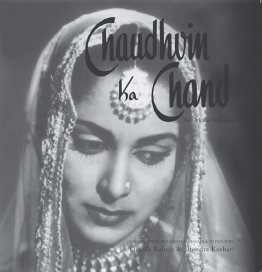The Original Screenplay
Authors : Dinesh Raheja and Jitendra Kothari
Publisher : Om Books International
Pages : 254
Price : Rs.595
In 1984, noted film maker Vijay Anand spoke about a book he treasured – Ten Best Hollywood Scripts, which he said was compiled from the shooting scripts. He then lamented the lack of bound scripts in the Hindi film industry, and that we had lost some treasures. Prophetic words, indeed.
The initiative launched by Vidhu Vinod Chopra to publish the original screenplay of three of Guru Dutt’s films – Sahib Bibi Aur Ghulam, Chaudhvin Ka Chand, and the yet to come Kagaz Ke Phool – is truly commendable. As India still hasn’t learnt the importance of archiving, screenplays were hard to come by, author Dinesh Raheja averred in an interview elsewhere. He was given a rough, salvaged screenplay of Sahib Bibi Aur Ghulam, so, he saw the film at least 40-50 times, before he and coauthor Jitendra Kothari could compile the book.
Guru Dutt’s magic
Perhaps no other filmmaker of yore has influenced contemporary Indian cinema as has Guru Dutt. In their essay ‘The Guru Dutt Effect’, the authors allude to Mukul Anand’s ‘Hum’ where “the aging protagonist (Amitabh Bachchan) is unable to reconcile with his one-time inamorata (Kimi Katkar) because of her autograph seeking fans, harking back to a similar sequence in Kagaz Ke Phool.” A scene from Sahib Bibi Aur Ghulam “in which a group of coach drivers discuss their masters’ fortunes finds an echo in Madhur Bhandarkars’ Page 3, which showed chauffeurs gossiping about their bosses while waiting outside a party.”
They further elucidate, that Guru Dutt was integral to the development of ‘Bromance’ (male bonding), the buzzing
genre of today’s films. Two buddies in love with the same girl or love triangle as it was then called often ended in
the death of one. Chaudhvin Ka Chand was the precursor to films like Sangam, Saagar, etc. Replete with grace, elegance and reverence, Chaudhvin Ka Chand also gave rise to the Muslim social genre.
The film – a classic
Though a film about male bonding (Guru Dutt and Rehman), it had a female centric title; Waheeda Rehman’s character is integral as the two friends fall in love with her. Yet the friendship between Johnny Walker, Guru Dutt and Rehman is pivotal. Set in Lucknow, where Islamic culture flourished. Another integral part of any Guru Dutt film, comic relief was provided by Johnny Walker. This tale of male bonding and romance remains one of the runaway hits of Guru Dutt; the film’s director, the veteran M Sadiq too made a resounding comeback.
Besides, the studied essay, interviews with the surviving cast and crew give a few behind-the-scenes insights. Initially, Waheeda Rehman was reluctant to sign the film, but relented because of Sadiq’s insistence. Despite the emergence of colour, the film was shot in black and white, yet it received a positive response. Later, Guru Dutt re-shot a couple of songs in colour and inserted them. The censors objected as Waheeda’s eyes were red and looked sensual. Guru Dutt had to explain the technicality saying that it was a song she was singing to her husband.
Chaudhvin Ka Chand didn’t have the casting carousel of Sahib Bibi Aur Ghulam, nor does it have any autobiographical reference like Kagaz Ke Phool. With the passage of years many associated with it have passed away; yet a few of them share some highlights: actress Farida Dadi (a child actor then) played Johnny Walker’s impish kid sister, costume designer Bhanu Athaiya, whose eye for detail and research had her craft authentic costumes for Meena Kumari and Waheeda Rehman in Sahib Bibi Aur Ghulam, Kagaz Ke Phool and Chaudhvin Ka Chand, and other actors of all three films.
Preserving cinematic literature
The screenplay, which is the raison d’ etre of the book and the series, is love’s labour, but not lost. The screenplay in Hindi (Devnagiri and Roman script) and its English translation are a boon to students especially. Considering Indian cinema is studied in universities elsewhere as well, the translations are handy references.
‘Chaudhvin Ka Chand: The Original Screenplay’ written by Dinesh Raheja and Jitendra Kothari makes the cut as a study aid since the screenplay is book-ended with the essay, ‘The Guru Dutt Effect’ and interviews with Waheeda Rehman, Bhanu Athaiya, Farida Dadi and others. Limited access to persona notwithstanding, the authors manage to evoke enough interest to make one want to watch the film after reading the book.

